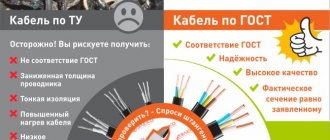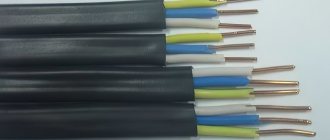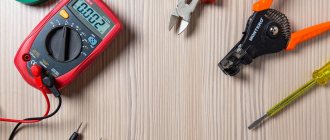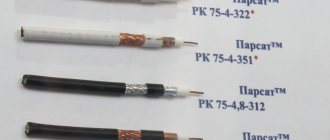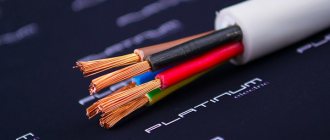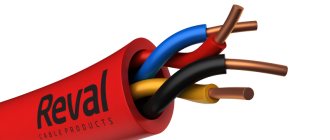Carrying out construction and repair work, as well as in modern design of electrical lighting sections, be it a residential building (for example, a house, apartment) or an industrial premises (plant, factory), we are constantly faced with the issue of choosing cable and wire products.
In this article, we will consider the choice between two popular brands of cables, namely NYM and VVGng. Both types are quite common when performing installation work. Let's consider their main characteristics, and also dwell on their distinctive features.
Application area
NYM cable can be used in various climatic zones, inside production facilities with low or high humidity levels, in domestic and living rooms and even outdoors.
When installing outdoors, it is important to avoid direct exposure to ultraviolet rays of the sun. Inside residential buildings, wire is used in different cases: both with open and hidden wiring. It is used to switch lighting equipment, electrical sockets, switches and other devices. When installing a line in open ground, the cable must be protected using corrugated pipes or special boxes. When laid aerially, NYM is reinforced with high-quality overpasses. For any electrical devices that require a seal at the input, it is best to use just such a cable.
Differences in the field of application of cables according to fire hazard
The scope of application of cables for fire hazard is given in GOST 31565-2012 “Cable products. Fire safety requirements."
This GOST 31565 applies to cable products that are subject to fire safety requirements, intended for installation in buildings and structures, and establishes classification, fire safety requirements, and preferred areas of application. GOST 31565 does not apply to cable products intended for installation in land and water, as well as to oil-filled cables, winding and bare wires.
Let us highlight the main differences in the use of VVG, VVGng(A) and VVGng(A)-LS cables in accordance with GOST 31565.
According to Table 2 of Section 6 “Preferential areas of application of cable products, taking into account their type of execution”:
| Type of cable product | Fire hazard class | Preferred area of application |
| Without designation | O1.8.2.5.4 | For single installation in cable structures and industrial premises. Group installation is permitted only in outdoor electrical installations and industrial premises, where only periodic presence of maintenance personnel is possible, and passive fire protection must be used |
| ng(A) | P1b.8.2.5.4 | For laying, taking into account the volume of flammable load of cables, in open cable structures (overpasses, galleries) of external electrical installations |
| ng(A)-LS | P1b.8.2.2.2 | For laying, taking into account the volume of flammable load of cables, in internal electrical installations, as well as in buildings, structures and closed cable structures |
Brief explanation of VVG cable markings in the video:
Color of conductors in the cable according to PUE 7, GOST R 50462 and GOST 31996
Requirements for cables according to PUE
Cables VVG 3x1.5 and 3x2.5 requirements for cores according to GOST and TU
What types of cables are there?
To create an electrical network, stranded and single-core wires can be used. Single-core ones have one braided cable. With this type of wire, the risk of short circuit is reduced. Stranded wires are made up of two or more cores that are insulated from each other and combined into one braid. To insulate a multi-core cable, a rubber coating is most often used, and the insulation of all wires is made of cotton fabric, which is impregnated with a special fire-resistant compound that prevents fires during a short circuit.
To create single-core and stranded wires, a single-wire structure or weaving several conductors into one can be used. All cables differ in names, types of external protective sheath, load capacity, and voltage loss.
Soft cable
In residential premises, soft multi-core cables are often installed. They consist of a large number of thin conductors, which are closely intertwined with each other and have a thin elastic braid. They are quite easy to place on wooden floors, walls, connect to sockets, and connect lighting, as they are quite easy to handle. Due to their flexibility and lightness, they are convenient to install, process, and replace. This type of cable has a drawback - when connecting electrical wiring, it must be crimped and a special tip pressed onto them.
Rigid cable
Each core separately consists of one conductor. It is usually able to bear greater loads, is much stronger than soft, but is more difficult to work with or replace. For wiring in city apartments, they prefer to choose three-core cables with grounding, which can prevent the consequences of a lightning strike into the building. The insulation of the cores in the cable usually has different colors. Red (brown) - determines the phase, blue - zero, and yellow corresponds to grounding.
It can be laid under wooden floors or placed in concrete partitions. It is not advisable to bend such a cable too much in one place, since it is not very flexible and elastic. For electrical wiring of any room, it is better to use a combination of soft and hard cables, choosing the one more suitable for a particular room and the potential load to be carried.
NYM
One of the most popular types of wires. This cable is often used for installing electrical wiring in apartments, wooden houses and premises, and cottages. Although it is not flexible, this option is optimal. It has two insulating layers, which makes it more fire resistant and safe. For wooden premises this factor is very important. It can also be laid under wooden floors, parquet or laminate.
VVG cable
A single-core type of wire, which is often used in apartments and private houses. It can have a round or flat shape. It is more compact than NYM, which makes it easier to install. VVG has a moderate cost, which makes it affordable.
Multi-wire PVA
This type of cable has better flexibility and elasticity. It is used for household appliances. PVA is not very good for creating long lines. Therefore, it is not often chosen for networking. When laying PVA in wooden premises, it is recommended to place the wire in a hollow metal casing. A qualified electrician can help you determine which cable is best installed in a particular location.
Explanation of the abbreviation NYM
The Latin abbreviation NYM stands for the following:
- N – standard type cable (German gradation);
- Y – the insulating sheath of the cores is made of polyvinyl chloride (PVC);
- M – with outer shell.
As usual, the absence of the letter “A” in the first place indicates that the cable cores are made of copper. In addition to the three standard letters in the designation, J or O can be added through a hyphen - with or without a yellow-green conductor (ground conductor).
After the alphabetic symbols there are necessarily digital symbols, indicating the number of cores and the cross-section of each of them. For example, the product NYM-O 4×4.5 - 0.66 can be deciphered as follows:
- standard cable with polyvinyl chloride core insulation and outer sheath;
- consists of four cores with a cross-sectional area of 4.5 square meters. mm each;
- used at voltages up to 0.66 kV (660 V).
Color coding
Such a cable must be produced with standardized color markings. The absence of this indicates that the product is not certified and is a counterfeit. The standards for the color of conductors are prescribed in the rules for electrical installations (PUE).
The set of colors varies depending on the exact number of cores located inside the outer sheath:
- there are no regulations for single-core cables;
- two conductors without a grounding cable - black and blue conductors;
- three cores without a grounding cable - black, brown and gray;
- four cores without a grounding cable - black, brown, gray and blue;
- three cores with a grounding cable - black, blue and yellow-green;
- four cores with a grounding cable - black, brown, gray and yellow-green;
- five cores with a grounding cable - black, brown, grey, blue and yellow-green.
Depending on the color marking, specialists can easily determine the main purpose of the cable. The blue wire is usually used to connect the neutral wire in single-phase networks. In three-phase, the blue core acts as a neutral. The yellow-green conductor in all cases serves as a grounding conductor.
Important! In accordance with GOST, the NYM cable should not contain conductors with white or white-blue insulation. If there is one, the conclusion is simple - it is a fake. Further use of such products, if possible, is at your own peril and risk.
ShVVP wire
The SHVVP cord is designed for connecting household appliances and devices to the electrical network. Its main function is a cord for connecting low-power equipment through an outlet to the network. The shell of the product is made of ordinary vinyl, and the insulating layer of each current-carrying core is made of the same material. Current conductors are multi-wire, copper with a cross-sectional area from 0.5 to 0.75 square meters. mm., there are two or three of them.
The cord insulation does not have high strength, so it is better not to use it under high loads. The ball screw is flat in design, the shell is absolutely white or black, the insulation of the current-carrying conductors is colored. Operating temperature from –25 to +70 °C.
In addition to connecting low-power household appliances and making simple extension cords, the ShVVP cord is often used in control and automation systems to power low-current circuits. The flexibility of the product is a very important parameter, which allows the wire to be used in a variety of areas. In addition, SHVVP is resistant to aggressive environments and can withstand air humidity up to 98%, which makes it moisture resistant.
Design features
VVGng is a power cable with copper conductors. The core insulation is made of polyvinyl chloride plastic. The insulation material contains additives that make it flame retardant. This conductor is available with a number of cores from 2 to 5. For ease of installation, the core insulation is color-coded, which can be done by completely painting the core insulation, or with a colored stripe. The outside of the cable is covered with a sheath made of the same PVC plastic as the core insulation. The core can have a single-wire or multi-wire design. The cross-sectional shape of the core can be round or segmented.
NYM is the designation of an analogue of the Russian product brand VVGng, produced according to the German standard VDE 0250. The number of cores also varies from 2 to 5. The insulation material is the same polyvinyl chloride, which does not support combustion. The main design difference between this product and its Russian counterpart is the presence of an additional non-flammable seal between the core insulation and the outer sheath of the cable.
Common Features for These Cables
According to clause 4.1 a)-e) GOST 31996-2012, the general characteristics for these VVG cables are:
clause 4.1 a) according to the material of current-carrying conductors: copper conductors (without designation);
clause 4.1 b) by type of insulation material of current-carrying conductors: insulation made of polyvinyl chloride plastic, including reduced fire hazard (B);
clause 4.1 c) by the presence and type of armor: unarmored (D),
clause 4.1 d) according to the type of material of the outer sheath or protective hose: made of polyvinyl chloride plastic, including reduced flammability or reduced fire hazard: outer sheath (B),
e) by the presence of a metal screen: without screen (without designation);
Various indications for these cables
According to clause 4.1 e)-g) GOST 31996-2012 decoding for these cables VVG, VVGng(A) and VVGng(A)-LS:
f) on performance in terms of fire danger indicators:
- flame retardant when installed alone (no designation);
- flame retardant during group installation (ng): according to category A - ng(A),
- flame retardant when installed in groups, with reduced smoke and gas emissions (ng-LS);
g) according to the cross-sectional shape of the cable:
- round (no designation);
- flat (P).
In accordance with clause 6.3.2, cables of versions “ng” and “ng-LS” should not spread fire when laid in groups. Test category A is established in the technical specifications for cables of specific brands.
According to clause 6.3.3, cables of “NG-LS” versions must have low smoke and gas emissions during combustion and smoldering.
How to choose a VVGng cable
Before purchasing a cable that is planned for use in home wiring, it is necessary to determine the required cross-section of the cores in accordance with the existing load. In this case, the cross-section must be taken with a margin.
When choosing a cable you need to check:
- veins;
- shape;
- section.
Veins
This element is the basis of the design of any cable. VVGng is produced in both single-core and multi-core versions (up to 5 cores).
You can judge the number of cores by the product labeling.
For example, VVGng 3x2.5 is three-core with a cross section of each 2.5 mm2. Each of the existing cores can be separate, or contain several separate wires woven together. This can also be determined by the labeling. Multi-wire conductors are marked with the letter M, a single-wire conductor is indicated with the letter O.
Form
Depending on the method of laying the cores, VVGng wire is produced:
- round, containing conductors of small cross-section and marked with the letter K;
- segmental (C), each core of which looks like a certain part of a circle;
- flat (P), in which the conductors of a small cross-section are laid along one plane.
A flat-shaped cable with small cross-section conductors is convenient for wall installation
Section
For VVGng cable, the cross-sectional area ranges from 1.5 to 50 mm2. However, wires with a cross-section of up to 400 mm2 are produced, manufactured according to special orders for certain projects.
Electrical products with a large cross-section have better conductivity, defined as the conductor resistance per 1 km of wire length.
Specifications
All technical data of the most used cable sections VVGng-LS, such as rated current, weight, resistance are presented in the tables below:
One important tip - even if you don’t yet have a grounding wire in your house and the system is TN-C and not TN-CS, still always buy only a three-core cable.
This way you won't have to redo all the wiring if you change your grounding system. Well, as a last resort, the third core will always remain a backup if a break occurs on the phase or neutral wire.
Where and how best to buy?
We hope that the information provided helped you decide which is better to choose for electrical wiring: NYM or VVGng, and also explained their similarities and differences. If you have any questions, be sure to ask them to the managers on the website https://xcabel.ru/. There you can order a high-quality and inexpensive cable that complies with GOST or TU.
Did you find this article helpful? Please share it on social networks: Don't forget to bookmark the Nedvio website. We talk about construction, renovation, and country real estate in an interesting, useful and understandable way.
KG – designed for harsh conditions
Perhaps the best solution for outdoor use is a cable marked KG. It has an insulating layer of rubber based on natural rubber. Moreover, such insulation is used both outside and for the cores themselves. This helps the product maintain high flexibility even in severe frost, and also makes it resistant to ultraviolet radiation - the shell does not crack. Withstands high air humidity. It is suitable for outdoor lighting of cottages, private houses, and enterprises. Can be used in car washes and production areas. It is often the basis for creating extension cords and powering equipment.
Understanding the labeling
- K – cable
- G – flexible
It has copper cores - from 1 to 5 pieces. The cross section can be up to 95 square meters. mm. For example, the 3x4 marking means that the cable is three-core and the cross-section of the cores is 4 square meters. mm. There are also additional letter designations: t – the cable is suitable for tropical zones and rooms with air humidity up to 98%; n – non-flammable with oil-resistant insulation; chl – resistant to cold, withstands frosts down to -60 °C.
Main characteristics
VVGng brand cables, regardless of subtype, are classified as power cables and can contain from 1 to 5 cores. A product with two cores is often used in home electrical wiring; a larger number of cores is required for production workshops and industrial premises.
Non-flammable cable VVGng with black coating with four conductive cores
Any type of VVGng cable has a minimum wire cross-section of 1.5 mm2. But the cable itself can have a much larger cross-section, reaching up to 230 mm2. The cross-section of the neutral wire depends on the thickness of the main conductors: with a cross-section of 1.5-2.5 mm2, the “zero” has a cross-section of 1.5 mm2.
The cable marking reads:
- B - vinyl coating;
- G - bare cable;
- ng - non-flammable material.
Thus, the cable has a “bare” core covered with a double layer of PVC insulation. The letter A missing in front of the abbreviation indicates that the electrical product is made from copper, not aluminum.
The main technical and operational properties of the cable are as follows:
- operating voltage - 660 and 1000 V;
- frequency - 50 Hz;
- the highest temperature for continuous heating of the cores is 70°C;
- ignition of the cores occurs when exposed to temperatures exceeding 250°C;
- the operating temperature of the cable at a humidity not higher than 98% is in the range -50 - 50°C;
- cable laying is allowed at temperatures not lower than -15°C;
- the minimum possible bending radius of the product is 7.5 cross-sectional radii for single-core types and 10 for multi-core types;
- electrical insulation resistance - 12 MΩ/km under normal conditions;
- service life - 30 years, warranty period - 5 years.
VVG – a safe solution for residential premises
If you ask electricians what is the most common type of cable for residential buildings, they will answer - VVG. This is the most popular solution for internal electrical networks and closed electrical installations with voltages up to 1 kV. The maximum service life is 30 years. This type of cable replaced PVS as more reliable. But at the same time, this is one of the most budget options on the market, which is why it is in such great demand.
Understanding the labeling
- B – PVC core insulation
- B – PVC outer sheath
- D – there is no external armor or other additional protective layers
It uses copper cores, which can be from 2 to 5 pieces. The manufacturer also indicates the cross section. For example, 3x2.5 indicates the presence of three cores and a cross-section of 2.5 square meters. mm.
There are several varieties in this category of electrical products:
- VVGng - does not propagate combustion due to special additives in the insulating layer; several cables can be laid in one channel without additional protection of each with corrugation;
- VVGng-ls is a non-flammable cable that produces a low amount of smoke when melted, therefore ideal for residential premises;
- VVGng-frls is perhaps the safest cable in this category, as it does not support combustion, has a low level of smoke generation, is resistant to high temperatures and even open fire, all thanks to additional mica insulation.
VVG is a very reliable cable that does not support combustion when installed alone. If several such cables are laid in a bundle in a channel, then each of them must be insulated in a separate corrugation.
Peculiarities
In certain respects, these two types are similar . Distinctive are the permissible temperature during operation, which for VVGng is within acceptable limits from -50C to +50C. The lifespan of such a cable is possible for thirty years. This conductor is not subject to combustion when laid in a group; it is used for equipment of power and lighting facilities that do not require a hermetically sealed seal at the entrances to the equipment.
NYM is used for indicators from -30С to +40С. Productivity is ten years longer and, according to the manufacturer, is forty years. Not subject to combustion only in a single gasket. It is recommended for installation at hazardous facilities, where complete sealing of inputs into equipment is necessary. It is better to choose it for a device in hazardous conditions.
NYM – confidence for many years
This is a German analogue of the VVG cable. Only it is manufactured in accordance with the German standard DIN VDE Normenleitung. It is characterized by high reliability, safety and long service life - up to 40 years. It is most often chosen for installation in apartments, cottages, office buildings, commercial and industrial premises. Many manufacturers offer frost-resistant cables, the operating temperature of which can reach -50 °C. Therefore they are suitable for installation in unheated rooms. Also, the NYM sheath is not afraid of ultraviolet radiation, unlike VVG - you can install the cable where direct sunlight hits. It is also easy to cut without special tools, which electricians appreciate.
Understanding the labeling
- N (normenleitung) – manufactured according to VDE standard
- Y (ysolationsschicht) – polyvinyl chloride insulation
- M (mantelleitung) – there is an outer shell
This type of cable can have from 1 to 7 copper cores. The cross section can reach 6 square meters. mm. You can find a product marked ls (low smoke), which means reduced smoke production when heated. The letter J indicates the presence of a yellow-green protective ground conductor. If there is no letter after the name or there is the letter O, this means there is no grounding conductor.
Explanation of the name
The decoding of the name NYM cable goes back to the old German classification system, according to the German national standard VDE 250, part 204. Currently, the European Union has a different marking system on a pan-European scale, but NYM at one time gained such wide popularity that it was able to maintain the authentic the name by which most European and Russian consumers know it.
So, the marking means the following:
- N - the product complies with the German standard VDE 250;
- Y - insulation is made of polyvinyl chloride;
- M - there is an outer protective shell.
There are two main subtypes of this wire - NYM-J and NYM-O. The letter J indicates the presence of a yellow-green wire in the product, intended for connecting the “ground”. O - for the absence of it. In this case, O may not be indicated on the marking of the coil or on the outer sheath of the cable; J is always indicated. Thus, NYM-J is a cable with a “ground” conductor, just NYM is without it.
Also, each wire of the NUM type is marked with the type 3×2.5, 1×4, and so on. This is a typical marking of the number of cores and their cross-section. The first number is the number of conductors, the second is the cross-section in square millimeters.
Note: a wire of this type can have from 1 to 7 cores of a wide range of cross-sections, up to 2.5 mm square. Some manufacturers, in particular Sevkabel, provide the service of manufacturing wires of the NYM standard with conductors of a larger cross-section - according to the customer’s needs.
Core cross-section
Unlike VVGng-LS, the VVGng cable has a smaller core cross-section, exclusively in relation to four-core and five-core power conductors. For example, four-core VVGng-LS has a cross-section of 70 mm2, and VVGng - 90 mm2. The same, but already five-core conductors, have the following cross-sections - 185 mm2 and 120 mm2, respectively.
Advantages and disadvantages
Among many conductors, NYM cable is considered to be the “golden mean”. To better understand its quality, let’s consider the main advantages of this product:
- Increased elasticity, ease of installation and operation. This flexibility is due to the presence of an internal insulating layer of rubber. This advantage is very important when performing any installation work on electrical wiring, as well as when installing equipment in inaccessible or hard-to-reach places. The wire is not affected by dampness and moisture, so it can be laid along the ground over long distances.
- If we talk about NYM, manufactured according to German quality standards, then before entering the market it must undergo numerous studies and tests. The Germans have long earned the title of the most reliable and high-quality manufacturers of industrial and other products, so there is no doubt about the integrity of the insulation and the compliance of the cable with all the declared technical and operational properties.
- The product does not support combustion, which was made possible due to the choice of material for the inner layer.
- Most specialists and electricians recommend using the product to connect lighting systems and power circuits.
- Long service life spanning several decades.
The most obvious disadvantage of NYM cable is its high cost. There are many domestic analogues, albeit with worse characteristics, the prices of which are several times lower.
What is the difference between NYM and VVGng
The NYM cable will be useful only for single installations. If you are planning a group session, then it is better to make a choice in favor of VVG. Structurally, both products consist of several copper cores with polyvinyl chloride insulation and the same outer shell. However, only VVGng (the prefix “ng” indicates the non-flammability of the cable) is able to stop the flame and prevent its spread during group installation of several conductors.
We list the main technical and operational characteristics of NYM and VVGng and compare them in the table below:
Characteristics Permissible voltage Current frequency Number of cores Cross-sectional area of one core Service life Filling of empty space Does not support the spread of fire Possibility of operation in difficult conditions
| NYM | VVGng |
| 660 V | 660 V |
| 50 Hz | 50 Hz |
| 2-5 pcs. | 1-5 pcs. |
| 1.5-35 sq. mm | 1.5-240 sq. mm |
| 40 years | 30 years |
| Present | Absent |
| Single gasket only | Any gasket, including group gasket |
| Moisture protection, not UV resistant | Can be used in any situation |
Comparison of parameters
It is more clear to compare data by combining the information in one tabular form. Elements of non-compliance are highlighted:
| Technical characteristics, standard size 3x4 | Meaning for | |
| NYM | VVGng | |
| Rated AC voltage with a frequency of 50 Hz, V | 660 | 660 |
| Temperature | ||
| Range of normal cable operation, °C | -50 ÷ +50 | -50 ÷ +50 |
| Maximum permissible temperature, no more, °C | 70 | 70 |
| Emergency long-term, no more than 8 hours, increase no more than °C | 80 | 80 |
| Permissible during short circuit for up to 4 sec, no more, °C | 160 | 160 |
| Air temperature at which installation without preheating is allowed, no colder, °C | -5 | -15 |
| Trial | ||
| Test voltage, V | 2000 | 3000 |
| Test time, min | 5 | 10 |
| Mechanical | ||
| Nominal insulation thickness | 0.8 | 0.7 |
| Nominal thickness of intermediate layer | 0.4 | No |
| Nominal Sheath Thickness | 1.6 | 1.5 |
| Weight of 1 kilometer of cable | 270 | 194 |
| Cable cross-sectional shape | Round | Round Flat |
| Permissible bending radius, outer diameters of the cable, no more than times | 4 | 7.5 |
| Possibility of sealing when entering equipment | Yes | No |
| Does not spread fire during installation, | Single | Group |
| The ability of the cable to draw in water, hygroscopicity | No | Yes |
| Sheath resistance to ultraviolet radiation | Below | Higher |
| Convenient cable termination | Higher | Below |
| Outer shell color | Light gray | Black |
| Nominal service life, not less, years | 30 | 30 |
| Price | Higher | Below |
There are differences in characteristics across many positions. The question of whether to purchase an NYM or VVGng cable cannot be resolved without a careful comparison of the inconsistencies that give different properties during installation and operation:
- Almost identical temperature ranges. The difference is that the plastic compound allows laying VVG without preheating at a lower air temperature, -15°C. NYM composite rubber does not allow operation below -5 degrees;
- Electrical tests of domestic products are more severe. 3000 volts for 10 minutes, versus 2 kV for 5 minutes. The testing requirements are explained by the thick insulation and sheath of the imported cable, and the presence of an additional middle layer of protection. These circumstances influenced weight gain;
- Soft vinyl and a layer of elastic rubber increased the flexibility of the NYM. This allows it to be laid individually with a smaller radius, making it easier to work on curved sections of the route. Of great importance is the ability to seal the insertion points of the shell in explosive areas. Rigid VVGng with a shell made of modified plastic has high fire-fighting properties, allowing for laying in bundles. Unlike its European counterpart, it is easier to withstand laying without UV protection outdoors;
- A layer of coated rubber, providing tightness, allows use in very wet places. It also makes it easier to cut NYM ends during installation. The subjectively more pleasant light color of the hose is easily marked with a felt-tip pen or marker when laying;
- The cost of VVGng is lower.
Selecting a cable for a specific application must take into account the features, characteristics, locations and installation conditions.
Manufacturers NYM
NYM cable is produced at foreign and domestic enterprises. The most popular factories in our country are:
- "Sevkabel";
- "Technoton";
- "Concord";
- "Pskovkabel";
- "Kamkabel".
Any products of these enterprises undergo all necessary stages of certification in accordance with international quality standards. For foreign companies, we will highlight the German TKD Kabel, Lapp Kabel and Helukabel, the French Nexans and the Turkish Denizli Cable.
NYM is stored and transported in special coils or drums, the diameter of which can be eight times the thickness of the cable itself. During storage, it is better to use a hard-to-reach and closed place, the minimum temperature of which is not lower than -15 degrees. Celsius. Also be sure to avoid direct exposure to direct sunlight.
Cable laying features
Despite the fact that the technical documentation states that the NYM wire is non-flammable, it would be a mistake to believe that it is absolutely not susceptible to fire. The main condition for non-flammability is the absence of bundles and other cables laid nearby.
Another feature of this brand of cable is its sensitivity to ultraviolet radiation, so it cannot be used in open spaces. On the other hand, the above VVGng has identical parameters and a much wider scope of application. It is suitable for both indoor and outdoor installations. VVGng can be safely used to enter an electric line from a pole to a house or when arranging a branch directly behind the SIP wire.
That is why many experts consider VVGng an improved analogue of the NYM cable. The foreign analogue is considered to be the MMJ wire, which is devoid of the above disadvantage. This is what is used for external installation.
Price policy
Of course, price is the main difference and the reason for choice. Pricing depends on the quantity and quality of materials used. In the case of the power cables under consideration, high-quality materials are used, up to tubular PVC braid, but their quantity is different. In the case of VVGng-LS there are more of them, and the production method is more complicated. These two factors influence the price, which, by the way, is higher, by approximately 12%, in relation to the above-mentioned VVGng.
VVGng(A)-LS
Life time
The estimated service life of VVG and NYM cables is at least 30 years.
At the same time, the wording “not less” means that if this cable is under 100% load in unfavorable conditions, it must work for AT LEAST 30 years.
And if there are the most ordinary conditions and the absence of a nominal load, then maybe all 50! It is these two main brands of cable, discussed in detail in the article, that are the most suitable and popular for installing electrical wiring, connecting sockets, switches and lighting.
There is another brand different from the two above that you may need in small quantities. But this is not a cable, but a wire - PV-3.
It is flexible, multi-core, easy to bend in small spaces and convenient to connect to machines via NShVI lugs. That is why it is used in the assembly of electrical panels.
Well, in the end, we will give a decoding of all the meanings of the letters in the cable brands, which are widely applicable in our electrical networks.
PUNP cable
This is a budget type of cable for electrical wiring. It is a flat two or three-core wire with a core cross-section from 0.75 to 6 mm2. PUNP stands for as follows:
- P - wire.
- UN is universal.
- P - flat shape.
Also in the abbreviation the letter “G” is sometimes found, which means that the wire is flexible. Its main advantage is its low cost compared to VVG and NYM.
There is an opinion among electricians that PUNP wire is prohibited for manufacture and use. Indeed, on June 1, 2007, a ban was introduced on the use of TU 16.K13-020-93 by members of the Elektrokabel association. However, manufacturing plants continue to produce and sell PUNP. In Russia they can be purchased freely.
Concerns about the use of PUNP are well founded. Statistics of fires caused by electrical wiring fires showed that in 60% of cases the source of fire was the PUNP cable type. The reason for this is that TU 16.K13-020-93 states that during the manufacture of wires, a deviation of 30% from GOST 22483-77 in the cross-section of current-carrying conductors is allowed. This means that, for example, a wire with a nominal cross-section of 4 mm2 may well be 2.9 mm2 or even less.
In general, whether to buy PUNP or not is up to you. In any case, if you have the means, it is better to purchase a wire of good quality once and not be afraid of a fire.
Tips for choosing
When going to the market for such a cable, be careful, since most of the products that sellers call the domestic analogue of NYM wire are fake. This is evidenced by the lack of necessary markings. When choosing a cable, pay attention to the logo and markings shown. Reliable and trusted manufacturers always put their own markings on the product. This already provides some kind of guarantee that the manufacturer is not afraid to bear responsibility for the products produced and is confident in their quality.
Sales consultants or ordinary market traders may recommend that you purchase SHVVP or PVS wires, stating that they are an excellent analogue of the NYM cable. You should not fall for such tricks, since in the case of SHVVP and PVS we are talking about ordinary cords. The main characteristic that distinguishes a cord from a cable product is related to its operational capabilities. The first is often suitable exclusively for switching household appliances and equipment, and the second is for connecting all wiring and more complex equipment.
Be sure to choose a cable with a grounding, yellow-green conductor, which will allow you to ensure high safety when operating equipment and home wiring. When choosing a product cross-section, you need to be guided by simple and general rules. When connecting lighting systems, it is enough to use wires with a cross-section of 1.5 square meters. mm, socket or switches - 2.5, oven or electric oven - from 4.5 sq. mm.
Despite the numerous domestic factories that are trying to produce high-quality NYM cable, in this case it is best to give preference to foreign factories from Germany, France or Turkey. Who knows, perhaps in a few years the situation will change, but for now we are forced to state this sad fact. In terms of operation, NYM is only suitable for internal single gasket applications. The product does not support any other options: you should not be fooled by the persuasion and deception of sellers!
Construction and section
Cable products are distinguished by cross-section, type of insulation, presence of armor, number of cores and their flexibility class. If we talk about lighting, then for stationary lamps, such as a chandelier or sconce, they require stationary (fixed) installation; a rigid wire or cable with a single-wire (monolithic) core is suitable for this. To connect a table lamp or a lamp that can change its position, you need a flexible core.
Let us immediately make a reservation that in home electrical wiring, including for lighting, the use of wires with aluminum conductors is prohibited by the requirements of the PUE. Therefore, modern electricians always use copper wires and cables for these purposes. It is also worth remembering that in a wooden house it is recommended to lay external wiring in corrugated pipes, pipes or cable ducts.
The cross-section of the core is selected based on the load connected to it. First, let's look at the table of permissible long-term currents through conductors:
Typically, electricians use a simplified rule: for sockets, use a cable with a cross-section of 2.5 square meters. mm. and more, for lighting circuits 1.5 sq. mm.
Why is it not advisable to use thick-section cores for all consumers? The fact is that the difference in cost is between 1.5 and 2.5 square meters. mm. approximately 1.3 times, in some cases even more. Accordingly, the cost of electrical wiring will be unreasonable and excessive.
But this is true for laying a line from the input circuit breaker to the distribution box. Further wiring can be done with a thinner wire. For example:
- You are going to connect a chandelier with five arms and install 100 W incandescent lamps in them. Then the current will be equal to 5*100/220=2.2 A.
- You need to connect a wall lamp, for example, a sconce with one light bulb. It will be used to create diffuse, dim lighting and you will install a 7W LED bulb. The current in this case will be extremely weak 0.03 A.
In both cases, a wire with a core cross-section of 1.5 square meters. mm is excessive, based on the table of permissible currents. It is also undesirable to choose a wire that is too thin, since in this case it is difficult to obtain reliable contact in screw and clamp terminal blocks. Therefore, in most cases, a 0.75 square meter wire is sufficient to connect lighting. mm. It will withstand current up to 14 A (more than 3 kW), and costs less than 1.5 sq. mm.
Choose a GOST or TU cable?
In a separate article, we looked at the differences between GOST and TU cables. In short, any cable is manufactured according to the technical specifications of the plant (abbreviated as TU). This means that the manufacturer declares certain conditions that the cable meets (resistance per 1 km of cable, sheath and insulation materials, filler, type of metal, etc.). At the same time, each plant has the opportunity to obtain compliance of its plant’s specifications with the state standard (abbreviated GOST).
If a plant receives GOST for its products, this means that the cable production plant’s specifications comply with the GOST standard. In common people, the cable that does not pass certification is called TU (because the cable complies with the Technical Conditions of the plant, but does not comply with GOST), and the cable that has passed certification is called GOST (that is, the plant’s specifications comply with GOST).
Very often we are asked the question - what to take, GOST or TU? This decision remains primarily yours. We, for our part, believe that the optimal cable in terms of quality-price ratio is the VVGng GOST cable - that is, a flat cable without filler, but made in accordance with GOST. It is more than enough for household needs.
Sources
- https://220.guru/electroprovodka/provoda-kabeli/kabel-nym.html
- https://buildingclub.ru/kabel-vvgng-3h25-i-3h15-treb-gost/
- https://chistayrabota.ru/kabel-nym-ili-num-raznica/
- https://domikelectrica.ru/luchshij-kabel-dlya-provodki-v-kvartire-nym-i-vvgng-ls-otlichiya-xarakteristiki/
- https://www.vseinstrumenti.ru/electrika-i-svet/kabel-i-provod/articles/tipy-kabelej/
- https://vchemraznica.ru/chem-otlichaetsya-kabel-vvgng-ot-vvgng-ls-opisanie-i-otlichiya/
- https://electric-220.ru/nym-ili-vvgng
[collapse]
